COCONUTS AND TACO'S!
March to May 2006
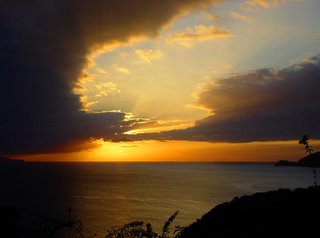 It begins in Antigua, the wind from aft and the poled out jib set. Next stop Panama, Atlantic side. The San Blas Islands is to be the destination for the next little while. I came here a few years ago, and was expecting a similar experience again.
It begins in Antigua, the wind from aft and the poled out jib set. Next stop Panama, Atlantic side. The San Blas Islands is to be the destination for the next little while. I came here a few years ago, and was expecting a similar experience again.
To sail into a place, which must have at least a few hundred, small coconut palm tree, coral reef surrounded, crystal clear water islands among it. Its a feeling of going back in time as a group of young Indian women, in full traditional dress, paddle there dug-out canoe to g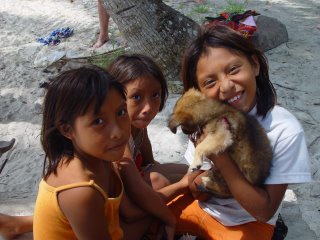 reet you. They are selling produce, and souvenir type items called ‘molas’ an embroidered pattern, which is on the ladies blouses. The ‘Kuna’s’ are small in stature, the second smallest race behind the Pigmy Indians.
reet you. They are selling produce, and souvenir type items called ‘molas’ an embroidered pattern, which is on the ladies blouses. The ‘Kuna’s’ are small in stature, the second smallest race behind the Pigmy Indians.
A smile is the first thing you notice, flashy white teeth, and often a young child attached to the hip. The laughter, and curiosity is childlike, only seen through adult eyes. Men are out fishing or diving for the family, or perhaps tending to the coconuts on the islands, ready for the market on the mainland. It’s all locally controlled and run by the Kuna’s, they have a president, and are separate from Panama.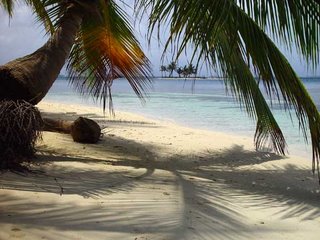
A well-preserved isthmus of islands moving into a new age, with all the traditions of the old remaining. This is however changing. Since last time I was here in 2004, there have been cell phone towers put up, and more and more customized dugouts to fit the westerner’s outboard motor. Its time that will change this place, not the people that survive here.
A sailing adventure through the San Blas islands is amazing, each island, some inhabited with family’s, some with nothing but p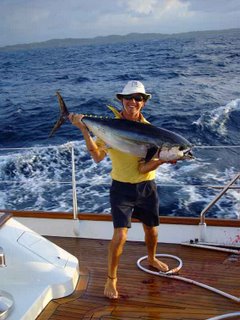 alms and sand. Others so full of people that you can barely walk between the palm thatch huts. It is a unique society that evolves here, and an understanding that keeps the visitors coming back each year for more.
alms and sand. Others so full of people that you can barely walk between the palm thatch huts. It is a unique society that evolves here, and an understanding that keeps the visitors coming back each year for more.
Trading with the ‘locals’, water for fish or crayfish is easily done, or for a small bit of cash the purchase of the Caribbean king crab is well worth it. Its not forced, but buying a few molas for friends back home is well worth it, the detail is more intricate, than any machine made product, plus you get a smile too.
Timoneer spent a few weeks in the San Blas; there were 2 sets of guests that came through. Both young and old, from the USA, were blown away at how the mainland can be only 100miles away, and people are surviving like this. There are cruise ships that come here, only a few islands that they visit, but the locals offer a numerous amount of tours into the jungle, even a business card, with cell-phone number attached.
To take a trek into the mainland is a tough one, the heat, humidity, and bugs are full on. But the reward of throwing your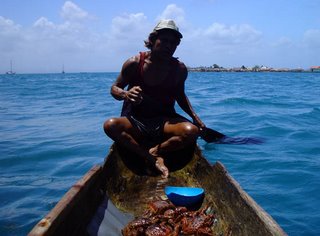 self into a crisp, clear mountain stream makes the sweat and itchiness disappear almost as quickly as it came.
self into a crisp, clear mountain stream makes the sweat and itchiness disappear almost as quickly as it came.
Last time I was here we found a island that was a sort of resort, its about a quarter football field in size, and makes the ideal getaway from everything. I mean everything! There is a very basic restaurant here, but u have to organize with the ‘Kuna Chef’ a few days prior if you want a to have a few friends over for dinner. The food is fresh, the beer is cold, and u are barefoot on a sandy island in paradise, how could you complain about that!
The Panama Canal system is one of the greatest creations of mankind in the 20th century. The lives lost and the general u ndertaking of the canal is incredible. The stories in the canal museum of the battle against mother nature, disease and the lack of funding to bring the canal to life, extraordinary to say the least. A creation of mans determination to succeed against adversity.
ndertaking of the canal is incredible. The stories in the canal museum of the battle against mother nature, disease and the lack of funding to bring the canal to life, extraordinary to say the least. A creation of mans determination to succeed against adversity.
Timoneer was set for its third transit through the canal system. But this time there was no 7 days in the Pacific then coming back through again. Anchored outside of the poverty stricken city of Colon, ready to travel 8 hours, up 85 vertical feet, and down to the mighty Pacific Ocean.
Panama is a country on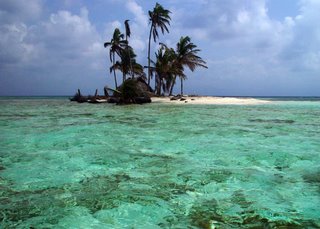 the rise, the beautiful coastline of both oceans, and the canal system seem to have panama moving forward very smartly. Its history in gold, slavery and the like have left the people of the land looking to the outside world for an answer, its come by the means of banking and tourism. It’s on the way up, and time will tell a good story about Panama in years to come.
the rise, the beautiful coastline of both oceans, and the canal system seem to have panama moving forward very smartly. Its history in gold, slavery and the like have left the people of the land looking to the outside world for an answer, its come by the means of banking and tourism. It’s on the way up, and time will tell a good story about Panama in years to come.
Taking the yacht north. Light wind, and glassy seas, greeted us on the journey away from the equator. Fishing for the elusive marlin, which is in abundance off the coastline. The sea life boiled the water many times, and being able to BBQ underway was a gift most easily taken.
In the south of Costa Rica, a lar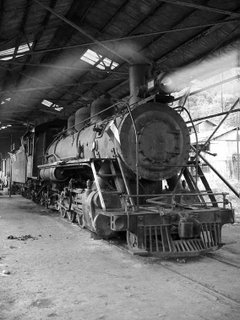 ge bay called ‘Golfito’. The rainforest came down to the waters edge, the heavens could open and produce an amazing 4 inches of rain in half an hour. The steamy condition of Costa Rica’s mainland is lush and dense. It’s no wonder that so many exotic plants, and birds thrive here; there is no lack of anything wild.
ge bay called ‘Golfito’. The rainforest came down to the waters edge, the heavens could open and produce an amazing 4 inches of rain in half an hour. The steamy condition of Costa Rica’s mainland is lush and dense. It’s no wonder that so many exotic plants, and birds thrive here; there is no lack of anything wild.
The small towns here, are fishing or farming based, its basic, but a needed aspect for a local community. You get weird looks from the locals, definitely a tourist in these parts.
On the move again: a short passage of 12 hours to the first marina stay of the trip. It turns out that sport fishing is a huge part of the seasonal income on the coastline. I wouldn’t be exaggerating if I said there were over 200 game boats. A lot with owners who fly into the private resort, fish, swim, shoot a round of golf and be back in the office on Monday morning. The development of the Costa Rican shore is not a new thing; there are condos and hotels strewn up and down the coast. We were fortunate enough to be able to use the Marriott hotel facilities. The chilled Venice style pool was a big hit, especially in the 35C heat of the day.
I explored the underwater world, a rocky reef opened up to 40 feet o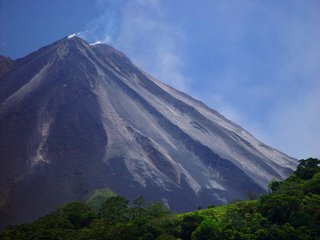 f water. The cool and warm water mixed in an oily slick, tropical fish of many colors and sizes filled the mask lens. It’s an exciting experience to dive in new locations, but with an air of what could else be down there watching you, I found this out later on…
f water. The cool and warm water mixed in an oily slick, tropical fish of many colors and sizes filled the mask lens. It’s an exciting experience to dive in new locations, but with an air of what could else be down there watching you, I found this out later on…
Watching the sunset over the western horizon for another time, waiting in anticipation for the often-mythical ‘green flash’ as the sun retracted its light around the earth. Mexico wasn’t far away now, and yet more smooth seas, and light breeze. The fish life still increasing day by day, watching the many turtles floating in the current with a sea bird hitching a ride perched high on its shell. We hooked a 20lb Wahoo, whilst I was filleting the most amazing thing happened. I’m not sure if it was the meatless ca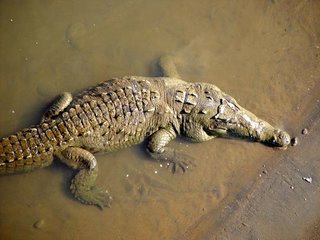 rcass, or the strategically places teaser lures that brought a very large marlin into the gear. It thrashed and ragged the teasers whilst my friend and I stood with a dumbfounded looks across our faces. The show lasted not much longer than 30 seconds, but its etched into my memory forever, very impressive display.
rcass, or the strategically places teaser lures that brought a very large marlin into the gear. It thrashed and ragged the teasers whilst my friend and I stood with a dumbfounded looks across our faces. The show lasted not much longer than 30 seconds, but its etched into my memory forever, very impressive display.
The anchored laid out at 30degrees off each bow and the stern tied to the dock. The city of Acapulco, famous for the daredevil cliff divers, who throw themselves off a 150-foot ledge into the foaming waters of the Pacific. It is a show, but by no means safe. The diver is trained up through the ranks, and taught the customs of the diver. Prayer, and skill are the surviving traits; timing could be thrown in there too! As the ocean recedes, the sh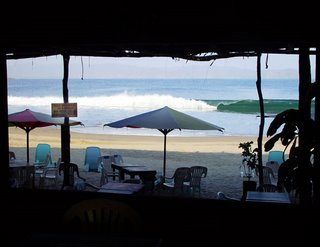 allow water becomes closer. The diver will climb the cliff face, pray, watch the sea, then fly out and into the water. They really do fly, using the crucifix style position to soar through the air and clear the rocks, to enter the water below.
allow water becomes closer. The diver will climb the cliff face, pray, watch the sea, then fly out and into the water. They really do fly, using the crucifix style position to soar through the air and clear the rocks, to enter the water below.
Mexico’s mainland was as it had been described; cactus, desert and dust. It grows on you though as I found out traveling further northwards. The countless small bays, with white sandy beaches, a small hut selling tacos, maybe a fish and fruit market also. You just never could tell what you might encounter at each new stop. Another thing that amazed me, was the amount of ‘Fiestas’. There seemed to be one happening, just starting, or just finished wherever we sailed into. The Mexican people really like to celebrate, right into the early hours of the next day most of the time. The more back street you went the more friendly it seemed to become, a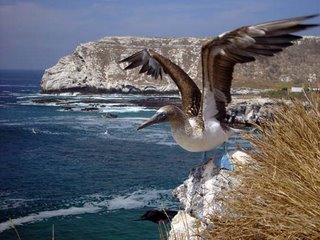 nd the small little restaurants, and cafes were always inviting for a quick tequila or 2! I didn’t see a main course over $10 dollars either, until arriving at the Americanized, Cabo San Lucas, on the southern end of the Baja Peninsula.
nd the small little restaurants, and cafes were always inviting for a quick tequila or 2! I didn’t see a main course over $10 dollars either, until arriving at the Americanized, Cabo San Lucas, on the southern end of the Baja Peninsula.
One of the highlights was at a small bird sanctuary island 60 miles off the mainland. There were no other boats there expect for the local fisherman, and a group of research students studying out of tents. The Isla Isabella use to be a volcano, and had a crater lake in the center, the toughest part was to find the trails though the hundreds and thousands of nesting seabirds. They were quite defensive if you came to close, but still incredible that places like this exist for the wildlife of the area. Its so neat to see close up a mother and her chicks in there grassy nests.
The clarity of the water turned to a turquoise blue, abundant with sea life.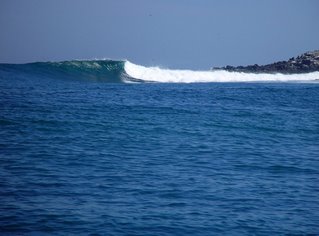 Night diving here was an absolute gift. Immersing yourself into the deep below with only a slither of moonlight around, 2 powerful halogen flashlights, and glow sticks attached to the tanks. A whole Martian landscape opened up as the beam of light passed over the seabed. To swim slowly over to a small puffer fish no larger than your hand, and actually be able to pick it up and hold it with out swimming away. Completely fast asleep, and unaware, an awesome eye-opening dive in the clear waters of the Pacific.
Night diving here was an absolute gift. Immersing yourself into the deep below with only a slither of moonlight around, 2 powerful halogen flashlights, and glow sticks attached to the tanks. A whole Martian landscape opened up as the beam of light passed over the seabed. To swim slowly over to a small puffer fish no larger than your hand, and actually be able to pick it up and hold it with out swimming away. Completely fast asleep, and unaware, an awesome eye-opening dive in the clear waters of the Pacific.
Making good speed and passing the hundreds of sport boats who run out of Cabo San Lucas, a quick fuel up, then t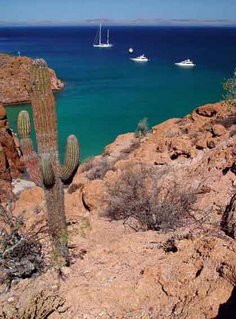 o the east coast of the Baja Peninsula. Little bays with some thing new to offer in each place. The cooler water and the amount of fish still surprised me; the Pacific currents pump the Sea of Cortez full of nutrient rich life. It is not uncommon to see whales breeching, a school of tuna, and the boiling sea surface of sardines created by the pack fishing sea birds. Seals who line some of the rocky islands, feeding on the abundance of marine life, and putting on a playful display for the snorkelers’ in the water, it’s a truly amazing place.
o the east coast of the Baja Peninsula. Little bays with some thing new to offer in each place. The cooler water and the amount of fish still surprised me; the Pacific currents pump the Sea of Cortez full of nutrient rich life. It is not uncommon to see whales breeching, a school of tuna, and the boiling sea surface of sardines created by the pack fishing sea birds. Seals who line some of the rocky islands, feeding on the abundance of marine life, and putting on a playful display for the snorkelers’ in the water, it’s a truly amazing place.
It was time to do some work, clean, scrub, polish and clean some more. Guests were arriving, and the trip was for 10 days, north for a while then down to Cabo for the drop off. The guests loved it, such a great cruising ground. Many mahi-mahi were caught, and mostly released, and my first marlin. On a lure I made up, set, played and released back into the ocean. Such a beautiful cr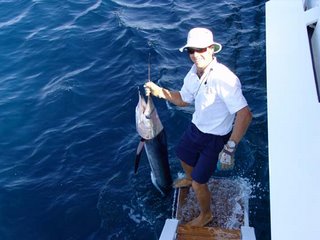 eature from the deep.
eature from the deep.
Sometimes you get lucky, and this was one of them. A guest we had on board for a few days owned a Villa over looking the south of the peninsula. The crew had the run off the 5-bedroom cliff house, which usually charges US$6500 per night, 4 full time staff, and all the luxury’s you could imagine. It felt weird to be looked after like that, but I think I could get use to it. The dream ended the next day, as the northwest winds howled through the rigging and the swells crashed over the bow. It was time to continue the northern passage to San Diego. As Mexico faded into the distance, my mind drifted back to all the places that have been, it is not at all as I could have believed, without seeing it with my own eyes. There is a kind of beauty here that grows on you, and helps you to see past the dry landscape to something very unique, and very special.
March to May 2006
 It begins in Antigua, the wind from aft and the poled out jib set. Next stop Panama, Atlantic side. The San Blas Islands is to be the destination for the next little while. I came here a few years ago, and was expecting a similar experience again.
It begins in Antigua, the wind from aft and the poled out jib set. Next stop Panama, Atlantic side. The San Blas Islands is to be the destination for the next little while. I came here a few years ago, and was expecting a similar experience again.To sail into a place, which must have at least a few hundred, small coconut palm tree, coral reef surrounded, crystal clear water islands among it. Its a feeling of going back in time as a group of young Indian women, in full traditional dress, paddle there dug-out canoe to g
 reet you. They are selling produce, and souvenir type items called ‘molas’ an embroidered pattern, which is on the ladies blouses. The ‘Kuna’s’ are small in stature, the second smallest race behind the Pigmy Indians.
reet you. They are selling produce, and souvenir type items called ‘molas’ an embroidered pattern, which is on the ladies blouses. The ‘Kuna’s’ are small in stature, the second smallest race behind the Pigmy Indians.A smile is the first thing you notice, flashy white teeth, and often a young child attached to the hip. The laughter, and curiosity is childlike, only seen through adult eyes. Men are out fishing or diving for the family, or perhaps tending to the coconuts on the islands, ready for the market on the mainland. It’s all locally controlled and run by the Kuna’s, they have a president, and are separate from Panama.

A well-preserved isthmus of islands moving into a new age, with all the traditions of the old remaining. This is however changing. Since last time I was here in 2004, there have been cell phone towers put up, and more and more customized dugouts to fit the westerner’s outboard motor. Its time that will change this place, not the people that survive here.
A sailing adventure through the San Blas islands is amazing, each island, some inhabited with family’s, some with nothing but p
 alms and sand. Others so full of people that you can barely walk between the palm thatch huts. It is a unique society that evolves here, and an understanding that keeps the visitors coming back each year for more.
alms and sand. Others so full of people that you can barely walk between the palm thatch huts. It is a unique society that evolves here, and an understanding that keeps the visitors coming back each year for more.Trading with the ‘locals’, water for fish or crayfish is easily done, or for a small bit of cash the purchase of the Caribbean king crab is well worth it. Its not forced, but buying a few molas for friends back home is well worth it, the detail is more intricate, than any machine made product, plus you get a smile too.
Timoneer spent a few weeks in the San Blas; there were 2 sets of guests that came through. Both young and old, from the USA, were blown away at how the mainland can be only 100miles away, and people are surviving like this. There are cruise ships that come here, only a few islands that they visit, but the locals offer a numerous amount of tours into the jungle, even a business card, with cell-phone number attached.
To take a trek into the mainland is a tough one, the heat, humidity, and bugs are full on. But the reward of throwing your
 self into a crisp, clear mountain stream makes the sweat and itchiness disappear almost as quickly as it came.
self into a crisp, clear mountain stream makes the sweat and itchiness disappear almost as quickly as it came.Last time I was here we found a island that was a sort of resort, its about a quarter football field in size, and makes the ideal getaway from everything. I mean everything! There is a very basic restaurant here, but u have to organize with the ‘Kuna Chef’ a few days prior if you want a to have a few friends over for dinner. The food is fresh, the beer is cold, and u are barefoot on a sandy island in paradise, how could you complain about that!
The Panama Canal system is one of the greatest creations of mankind in the 20th century. The lives lost and the general u
 ndertaking of the canal is incredible. The stories in the canal museum of the battle against mother nature, disease and the lack of funding to bring the canal to life, extraordinary to say the least. A creation of mans determination to succeed against adversity.
ndertaking of the canal is incredible. The stories in the canal museum of the battle against mother nature, disease and the lack of funding to bring the canal to life, extraordinary to say the least. A creation of mans determination to succeed against adversity.Timoneer was set for its third transit through the canal system. But this time there was no 7 days in the Pacific then coming back through again. Anchored outside of the poverty stricken city of Colon, ready to travel 8 hours, up 85 vertical feet, and down to the mighty Pacific Ocean.
Panama is a country on
 the rise, the beautiful coastline of both oceans, and the canal system seem to have panama moving forward very smartly. Its history in gold, slavery and the like have left the people of the land looking to the outside world for an answer, its come by the means of banking and tourism. It’s on the way up, and time will tell a good story about Panama in years to come.
the rise, the beautiful coastline of both oceans, and the canal system seem to have panama moving forward very smartly. Its history in gold, slavery and the like have left the people of the land looking to the outside world for an answer, its come by the means of banking and tourism. It’s on the way up, and time will tell a good story about Panama in years to come.Taking the yacht north. Light wind, and glassy seas, greeted us on the journey away from the equator. Fishing for the elusive marlin, which is in abundance off the coastline. The sea life boiled the water many times, and being able to BBQ underway was a gift most easily taken.
In the south of Costa Rica, a lar
 ge bay called ‘Golfito’. The rainforest came down to the waters edge, the heavens could open and produce an amazing 4 inches of rain in half an hour. The steamy condition of Costa Rica’s mainland is lush and dense. It’s no wonder that so many exotic plants, and birds thrive here; there is no lack of anything wild.
ge bay called ‘Golfito’. The rainforest came down to the waters edge, the heavens could open and produce an amazing 4 inches of rain in half an hour. The steamy condition of Costa Rica’s mainland is lush and dense. It’s no wonder that so many exotic plants, and birds thrive here; there is no lack of anything wild.The small towns here, are fishing or farming based, its basic, but a needed aspect for a local community. You get weird looks from the locals, definitely a tourist in these parts.
On the move again: a short passage of 12 hours to the first marina stay of the trip. It turns out that sport fishing is a huge part of the seasonal income on the coastline. I wouldn’t be exaggerating if I said there were over 200 game boats. A lot with owners who fly into the private resort, fish, swim, shoot a round of golf and be back in the office on Monday morning. The development of the Costa Rican shore is not a new thing; there are condos and hotels strewn up and down the coast. We were fortunate enough to be able to use the Marriott hotel facilities. The chilled Venice style pool was a big hit, especially in the 35C heat of the day.
I explored the underwater world, a rocky reef opened up to 40 feet o
 f water. The cool and warm water mixed in an oily slick, tropical fish of many colors and sizes filled the mask lens. It’s an exciting experience to dive in new locations, but with an air of what could else be down there watching you, I found this out later on…
f water. The cool and warm water mixed in an oily slick, tropical fish of many colors and sizes filled the mask lens. It’s an exciting experience to dive in new locations, but with an air of what could else be down there watching you, I found this out later on…Watching the sunset over the western horizon for another time, waiting in anticipation for the often-mythical ‘green flash’ as the sun retracted its light around the earth. Mexico wasn’t far away now, and yet more smooth seas, and light breeze. The fish life still increasing day by day, watching the many turtles floating in the current with a sea bird hitching a ride perched high on its shell. We hooked a 20lb Wahoo, whilst I was filleting the most amazing thing happened. I’m not sure if it was the meatless ca
 rcass, or the strategically places teaser lures that brought a very large marlin into the gear. It thrashed and ragged the teasers whilst my friend and I stood with a dumbfounded looks across our faces. The show lasted not much longer than 30 seconds, but its etched into my memory forever, very impressive display.
rcass, or the strategically places teaser lures that brought a very large marlin into the gear. It thrashed and ragged the teasers whilst my friend and I stood with a dumbfounded looks across our faces. The show lasted not much longer than 30 seconds, but its etched into my memory forever, very impressive display.The anchored laid out at 30degrees off each bow and the stern tied to the dock. The city of Acapulco, famous for the daredevil cliff divers, who throw themselves off a 150-foot ledge into the foaming waters of the Pacific. It is a show, but by no means safe. The diver is trained up through the ranks, and taught the customs of the diver. Prayer, and skill are the surviving traits; timing could be thrown in there too! As the ocean recedes, the sh
 allow water becomes closer. The diver will climb the cliff face, pray, watch the sea, then fly out and into the water. They really do fly, using the crucifix style position to soar through the air and clear the rocks, to enter the water below.
allow water becomes closer. The diver will climb the cliff face, pray, watch the sea, then fly out and into the water. They really do fly, using the crucifix style position to soar through the air and clear the rocks, to enter the water below.Mexico’s mainland was as it had been described; cactus, desert and dust. It grows on you though as I found out traveling further northwards. The countless small bays, with white sandy beaches, a small hut selling tacos, maybe a fish and fruit market also. You just never could tell what you might encounter at each new stop. Another thing that amazed me, was the amount of ‘Fiestas’. There seemed to be one happening, just starting, or just finished wherever we sailed into. The Mexican people really like to celebrate, right into the early hours of the next day most of the time. The more back street you went the more friendly it seemed to become, a
 nd the small little restaurants, and cafes were always inviting for a quick tequila or 2! I didn’t see a main course over $10 dollars either, until arriving at the Americanized, Cabo San Lucas, on the southern end of the Baja Peninsula.
nd the small little restaurants, and cafes were always inviting for a quick tequila or 2! I didn’t see a main course over $10 dollars either, until arriving at the Americanized, Cabo San Lucas, on the southern end of the Baja Peninsula.One of the highlights was at a small bird sanctuary island 60 miles off the mainland. There were no other boats there expect for the local fisherman, and a group of research students studying out of tents. The Isla Isabella use to be a volcano, and had a crater lake in the center, the toughest part was to find the trails though the hundreds and thousands of nesting seabirds. They were quite defensive if you came to close, but still incredible that places like this exist for the wildlife of the area. Its so neat to see close up a mother and her chicks in there grassy nests.
The clarity of the water turned to a turquoise blue, abundant with sea life.
 Night diving here was an absolute gift. Immersing yourself into the deep below with only a slither of moonlight around, 2 powerful halogen flashlights, and glow sticks attached to the tanks. A whole Martian landscape opened up as the beam of light passed over the seabed. To swim slowly over to a small puffer fish no larger than your hand, and actually be able to pick it up and hold it with out swimming away. Completely fast asleep, and unaware, an awesome eye-opening dive in the clear waters of the Pacific.
Night diving here was an absolute gift. Immersing yourself into the deep below with only a slither of moonlight around, 2 powerful halogen flashlights, and glow sticks attached to the tanks. A whole Martian landscape opened up as the beam of light passed over the seabed. To swim slowly over to a small puffer fish no larger than your hand, and actually be able to pick it up and hold it with out swimming away. Completely fast asleep, and unaware, an awesome eye-opening dive in the clear waters of the Pacific.Making good speed and passing the hundreds of sport boats who run out of Cabo San Lucas, a quick fuel up, then t
 o the east coast of the Baja Peninsula. Little bays with some thing new to offer in each place. The cooler water and the amount of fish still surprised me; the Pacific currents pump the Sea of Cortez full of nutrient rich life. It is not uncommon to see whales breeching, a school of tuna, and the boiling sea surface of sardines created by the pack fishing sea birds. Seals who line some of the rocky islands, feeding on the abundance of marine life, and putting on a playful display for the snorkelers’ in the water, it’s a truly amazing place.
o the east coast of the Baja Peninsula. Little bays with some thing new to offer in each place. The cooler water and the amount of fish still surprised me; the Pacific currents pump the Sea of Cortez full of nutrient rich life. It is not uncommon to see whales breeching, a school of tuna, and the boiling sea surface of sardines created by the pack fishing sea birds. Seals who line some of the rocky islands, feeding on the abundance of marine life, and putting on a playful display for the snorkelers’ in the water, it’s a truly amazing place.It was time to do some work, clean, scrub, polish and clean some more. Guests were arriving, and the trip was for 10 days, north for a while then down to Cabo for the drop off. The guests loved it, such a great cruising ground. Many mahi-mahi were caught, and mostly released, and my first marlin. On a lure I made up, set, played and released back into the ocean. Such a beautiful cr
 eature from the deep.
eature from the deep.Sometimes you get lucky, and this was one of them. A guest we had on board for a few days owned a Villa over looking the south of the peninsula. The crew had the run off the 5-bedroom cliff house, which usually charges US$6500 per night, 4 full time staff, and all the luxury’s you could imagine. It felt weird to be looked after like that, but I think I could get use to it. The dream ended the next day, as the northwest winds howled through the rigging and the swells crashed over the bow. It was time to continue the northern passage to San Diego. As Mexico faded into the distance, my mind drifted back to all the places that have been, it is not at all as I could have believed, without seeing it with my own eyes. There is a kind of beauty here that grows on you, and helps you to see past the dry landscape to something very unique, and very special.

